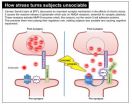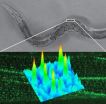(Press-News.org) Dogs generally seem to be cheerful, happy-go-lucky characters, so you might expect that most would have an optimistic outlook on life.
In fact some dogs are distinctly more pessimistic than others, research from the University of Sydney shows.
"This research is exciting because it measures positive and negative emotional states in dogs objectively and non-invasively. It offers researchers and dog owners an insight into the outlook of dogs and how that changes," said Dr Melissa Starling, from the Faculty of Veterinary Science. Her PhD research findings are published in PLOS today.
"Finding out as accurately as possible whether a particular dog is optimistic or pessimistic is particularly helpful in the context of working and service dogs and has important implications for animal welfare."
Dogs were taught to associate two different sounds (two octaves apart) with whether they would get the preferred reward of milk or instead get the same amount of water. Once the dogs have learnt the discrimination task, they are presented with 'ambiguous' tones.
If dogs respond after ambiguous tones, it shows that they expect good things will happen to them, and they are called optimistic. They can show how optimistic they are by which tones they respond to. A very optimistic dog may even respond to tones that sound more like those played before water is offered.
"Of the dogs we tested we found more were optimistic than pessimistic but it is too early to say if that is true of the general dog population," said Dr Starling.
However it does mean that both individuals and institutions (kennels, dog minders) can have a much more accurate insight into the emotional make-up of their dogs.
According to the research a dog with an optimistic personality expects more good things to happen, and less bad things. She will take risks and gain access to rewards. She is a dog that picks herself up when things don't go her way, and tries again. Minor setbacks don't bother her.
If your dog has a pessimistic personality, he expects less good things to happen and more bad things. This may make him cautious and risk averse. He may readily give up when things don't go his way, because minor setbacks distress him. He may not be unhappy per se, but he is likely to be most content with the status quo and need some encouragement to try new things.
"Pessimistic dogs appeared to be much more stressed by failing a task than optimistic dogs. They would whine and pace and avoid repeating the task while the optimistic dogs would appear unfazed and continue," said Dr Starling.
"This research could help working dog trainers select dogs best suited to working roles. If we knew how optimistic or pessimistic the best candidates for a working role are, we could test dogs' optimism early and identify good candidates for training for that role. A pessimistic dog that avoids risks would be better as a guide dog while an optimistic, persistent dog would be more suited to detecting drugs or explosives."
Dr Starling has been working with Assistance Dogs Australia, a charity organisation that provides service and companion dogs to people with disabilities, to investigate whether an optimism measure could aid in selecting suitable candidates for training.
The research not only suggests how personality may affect the way dogs see the world and how they behave but how positive or negative their current mood is.
"This research has the potential to completely remodel how animal welfare is assessed. If we know how optimistic or pessimistic an animal usually is, it's possible to track changes in that optimism that will indicate when it is in a more positive or negative emotional state than usual," said Dr Starling.
"The remarkable power of this is the opportunity to essentially ask a dog 'How are you feeling?' and get an answer. It could be used to monitor their welfare in any environment, to assess how effective enrichment activities might be in improving welfare, and pinpoint exactly what a dog finds emotionally distressing."
INFORMATION:
Media enquiries:
Verity Leatherdale: (02) 9351 4312, 0403 067 342 or verity.leatherdale@sydney.edu.au
Dogs can be pessimists too
Cognitive bias in dogs
2014-09-18
ELSE PRESS RELEASES FROM THIS DATE:
The viability of premature babies is minimal at 22 weeks' gestation
2014-09-18
A new study analyses the survival rates in Spain of newborns with a gestational age under 26 weeks. The results show that survival under 23 weeks is 'exceptional', although other factors such as birth weight and sex also have an influence.
Experts from the Spanish Society of Neonatology have studied the survival rates in Spain of newborns with a gestational age under 26 weeks, taking into account that a newborn carried to term is between 37 and 42 weeks.
The data have been drawn from the national database that gathers information on all babies born weighing less than ...
A second look at glaucoma surgery
2014-09-18
New research led by Queen's University professor Robert Campbell (Ophthalmology) has revealed using anti-inflammatory medications after glaucoma laser surgery is not helpful or necessary.
Glaucoma is the most common cause of irreversible blindness in the world and about 400,000 Canadians are afflicted with the disease, which is mainly caused by pressure within the eye being high enough to damage the optic nerve. The optic nerve is responsible for sending messages from the eye to the brain and is a vital part of vision.
"The use of strong anti-inflammatory therapies after ...
Tropical fish a threat to Mediterranean Sea ecosystems
2014-09-18
The tropical rabbitfish which have devastated algal forests in the eastern Mediterranean Sea pose a major threat to the entire Mediterranean basin if their distribution continues to expand as the climate warms, a new study warns.
The study, by an international team of researchers led by Dr Adriana Vergés of UNSW Australia and Dr Fiona Tomas of the Mediterranean Institute for Advanced Studies in Spain, is published in the Journal of Ecology.
Members of the team surveyed more than 1000 kilometres of coastline in Turkey and Greece, where two species of rabbitfish have become ...
University of Kentucky research explores STXBP5 gene and its role in blood clotting
2014-09-18
LEXINGTON, Ky (Sept. 17, 2014) -- Two independent groups of researchers led by Sidney (Wally) Whiteheart, PhD, of the University of Kentucky, and Charles Lowenstein, MD, of the University of Rochester, have published important studies exploring the role that a gene called STXBP5 plays in the development of cardiovascular disease.
According to Whiteheart, previous genome-wide association studies (GWAS) identified a gene called STXBP5 as a factor that regulates a protein called Von Willebrand factor (VWF).
VWF is an important contributor to normal blood clotting. When ...
UT Dallas study uncovers factors in students' reporting of weapons at school
2014-09-18
As a result of outbreaks of violence in the nation's schools, concerns have grown about school safety and the overall well-being of students.
In a new study, UT Dallas criminology researchers have found that certain factors affect students' willingness to report weapons at school.
"A big part of adolescent development is figuring out your identity, and that does not always mean talking to grown-ups about what is going on," said Dr. Nadine Connell, assistant professor of criminology in the School of Economic, Political and Policy Sciences. "We can't stop students from ...
Improving medicines for children in Canada
2014-09-18
Ottawa (September 18, 2014) – A new expert panel report, Improving Medicines for Children in Canada, released today by the Council of Canadian Academies, addresses the importance of developing safe and effective medicines for children. Each year about half of Canada's seven million children use at least one prescription drug. Much of this prescribing is done off-label (i.e. the prescription differs from the authorized use), creating potential health risks.
Children have historically been excluded in drug research and development, including clinical trials. As a result, ...
Rosuvastatin treatments particularly effective among prediabetic patients
2014-09-18
Los Angeles, CA (September 18, 2014) Cardiovascular disease is the leading causes of death worldwide and high cholesterol plays a major role in accelerating its progression. Medical practitioners have turned to statins as a treatment to decrease cholesterol-carrying lipoproteins such as small dense lipoproteins (sdLDL), considered to be especially harmful. A new study, out today in the Journal of Cardiovascular Pharmacology and Therapeutics finds that rosuvastatin may be more effective among prediabetic patients than patients with normal glucose levels.
Study author ...
Middle school dilemma: Girls' body image affected by older peers
2014-09-18
Los Angeles, CA (September 18, 2014) The media is highly criticized for contributing to body image issues in adolescents. However, a study out today in Psychology of Women Quarterly finds a different source for body dissatisfaction among young girls: older girls at school.
A research team led by Jaine Strauss, Professor of Psychology at Macalester College, surveyed 1,536 5th through 8th-grade female students attending schools with different grade groupings. Some 5th and 6th graders attended school with older students (i.e. in districts that follow the "middle school" ...
How stress tears us apart
2014-09-18
Why is it that when people are too stressed they are often grouchy, grumpy, nasty, distracted or forgetful? Researchers from the Brain Mind Institute (BMI) at EPFL have just highlighted a fundamental synaptic mechanism that explains the relationship between chronic stress and the loss of social skills and cognitive impairment. When triggered by stress, an enzyme attacks a synaptic regulatory molecule in the brain. This was revealed by a work published in Nature Communications.
Carmen Sandi's team went to look for answers in a region of the hippocampus known for its involvement ...
Scientists pioneer microscopy technique that yields fresh data on muscular dystrophy
2014-09-18
Scientists at USC have developed a new microscopy technology that allows them to view single molecules in living animals at higher-than-ever resolution.
Dubbed "Complementation Activated Light Microscopy" (CALM), the new technology allows imaging resolutions that are an order of magnitude finer than conventional optical microscopy, providing new insights into the behavior of biomolecules at the nanometer scale.
In a paper published on Sept. 18 by Nature Communications, the researchers behind CALM used it to study dystrophin – a key structural protein of muscle cells ...
LAST 30 PRESS RELEASES:
Empty-handed neurons might cause neurodegenerative diseases
Black women hospitalised in USA with blood infection resistant to last-resort antibiotic at increased risk of death
NEC Society Statement on the Watson vs. Mead Johnson Verdict
Lemur’s lament: When one vulnerable species stalks another
Surf clams off the coast of Virginia reappear – and rebound
Studying optimization for neuromorphic imaging and digital twins
ORNL researchers win Best Paper award for nickel-based alloy tailoring
New beta-decay measurements in mirror nuclei pin down the weak nuclear force
Study uncovers neural mechanisms underlying foraging behavior in freely moving animals
Gene therapy is halting cancer. Can it work against brain tumors?
New copper-catalyzed C-H activation strategy from Scripps Research
New compound from blessed thistle promotes functional nerve regeneration
Auburn’s McCrary Institute, ORNL to partner on first regional cybersecurity center to protect the nation’s electricity grid
New UNC-Chapel Hill study examines the increased adoption of they/them pronouns
Groundbreaking study reveals potential diagnostic marker for multiple sclerosis years before symptom onset
Annals of Internal Medicine presents breaking scientific news at ACP’s Internal Medicine Meeting 2024
Scientists discover new way to extract cosmological information from galaxy surveys
Shoe technology reduces risk of diabetic foot ulcers
URI-led team finds direct evidence of ‘itinerant breeding’ in East Coast shorebird species
Wayne State researcher aims to improve coding peer review practices
Researchers develop a new way to safely boost immune cells to fight cancer
Compact quantum light processing
Toxic chemicals from microplastics can be absorbed through skin
New research defines specific genomic changes associated with the transmissibility of the monkeypox virus
Registration of biological pest control products exceeds that of agrochemicals in Brazil
How reflecting on gratitude received from family can make you a better leader
Wearable technology assesses surgeons’ posture during surgery
AATS and CRF® partner on New York Valves: The structural heart summit
Postpartum breast cancer and survival in women with germline BRCA pathogenic variants
Self-administered acupressure for probable knee osteoarthritis in middle-aged and older adults
[Press-News.org] Dogs can be pessimists tooCognitive bias in dogs




